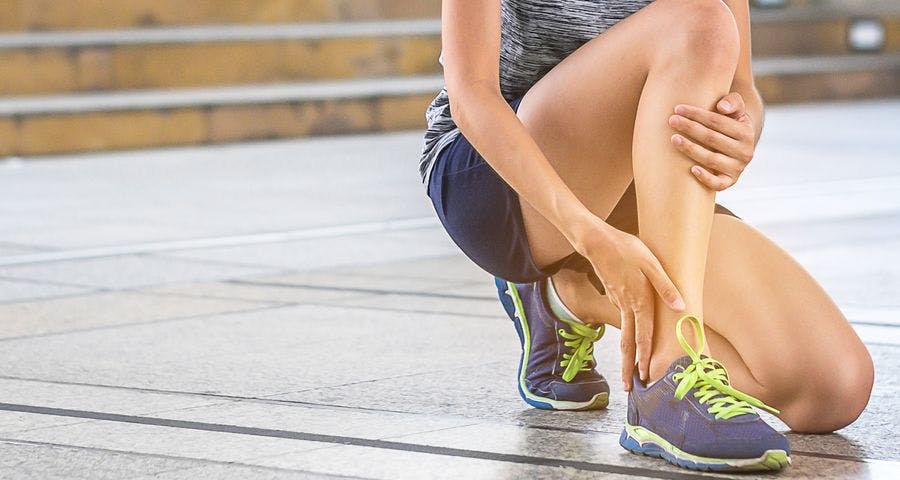Finding Ankle Pain Relief: Causes and Treatment Options
Minor Arthritis & Joint Pain
Is ankle pain slowing you down? Read this article from Advil to learn about the causes of ankle pain and how you can treat it. The tips listed below can help provide ankle pain relief to make you feel as good as new in no time.
About Ankle Pain
Ankles connect the bones in the leg to the bones in the feet and help us move our feet upwards, downwards, and side to side.1 We use our ankles often, so keeping these joints pain-free is essential to us remaining comfortable. You don’t need to be a competitive athlete to experience ankle pain. Whether you like to run marathons or prefer leisurely strolls around the block, ankle pain is a potential problem for many of us. In fact, research estimates that around 9% to 15% of adults suffer from ankle pain from osteoarthritis alone. 2 There are others causes of ankle pain as well. The duration of the pain, as well as the severity, depends on the cause. Identifying the cause will help you determine the best option for ankle pain treatment. Read on to learn about potential causes of ankle pain.
Ankle Pain Causes
Ankle pain may be chronic or temporary. Luckily, in many cases, it’s the latter. Determining the cause of your ankle pain is the first step in finding relief. According to the American College of Foot and Ankle Surgeons, potential causes of ankle pain include the following:3
- Ankle sprain (most common)
- Ankle instability
- Arthritis
- Gout
- Tendonitis
- Fracture
- Nerve compression
- Infection
- Poor structural alignment of the leg or foot
Sometimes, ankle pain starts on its own, but other times it may be accompanied by swelling, stiffness, redness, or warmth.4 If you notice these symptoms and you’re concerned your ankle pain is an indicator of a more serious condition, consult a healthcare professional as soon as possible.
Ankle Pain Treatment
If you’re seeking ankle pain relief, there are various options available to you. Explore the information below to learn more about ankle pain treatment options.
Stretch.
Stretching is a nice way to help alleviate ankle pain. A few simple stretches may be particularly helpful if your pain is due to overuse and/or arthritis.4 If you have arthritis, stretching helps to promote the lubrication of the joints and enhance your range-of-motion.4 Incorporate some ankle stretches into your morning routine, or do a few ankle stretches before you go to bed in the evening. While there isn’t much evidence that stretching prevents injuries, it can’t hurt to stretch before and after you work out as well. If you’re new to stretching, try yoga to learn fun, easy stretches you can do for your ankles.
Rest.
If you’ve experienced an ankle injury, rest can be helpful in the healing process. Ankle injuries include sprains and fractures, amongst others. Do your best to keep weight off of your ankle, and take a break from your ordinary activities. Avoid strenuous exercise that puts pressure on your joints, such as running, at least until you’ve recovered. Pro tip: try elevating your foot on a chair or stack of pillows. Elevation can help reduce the swelling.5
Ice.
Ice is an effective ankle pain treatment. Similar to elevation, ice can help reduce pain and swelling.5 If you decide to ice your ankle, be sure to protect your skin. Wrap a towel around the ice pack to reap the benefits of the ice, while still doing so at a temperature that is safe for your skin. You don’t need to ice for long (because we know it’s cold!) Simply ice for a few minutes at repeated intervals throughout the day or until symptoms alleviate.
Compression.
Compression can help reduce ankle pain from an injury. When you wrap the injured area with a compression bandage, you can help alleviate the swelling.5 Ensure the bandage is wrapped comfortably and isn’t too tight. If the bandage is too tight, it might cut off circulation and cause numbness. Keep the compression bandage on until symptoms abide. Contact your doctor if you don’t notice any changes after 24 hours.
Eat Well, Hydrate Often.
A well-rounded, nutritious diet can help support pain-free joints. If you’re having ankle pain, check your diet to make sure you’re consuming enough healthy fats and protein. Load up fruits and veggies rich in antioxidants to help with inflammation. Avoid excessive alcohol, which may dehydrate and make conditions like gout worse. In addition, a healthy diet can help lead to a healthy weight, which is one of the best ways you can help protect and support your joints.
Use Over-The-Counter Painkillers.
If you’re looking for a quick way to relieve the pain, over-the-counter pain medications may help. Nonsteroidal anti-inflammatory drugs (NSAIDs) can help relieve the pain caused by inflammation.5 For safe, effective pain relief, try taking Advil Tablets. Advil Tablets are good for temporarily relieving types of pain that can affect your ankles, including muscular aches and minor arthritis pain. You can also try Advil Dual Action, which combines acetaminophen and ibuprofen for powerful, long-lasting pain relief.
Wear Supportive Shoes.
Wearing the right shoes can make all the difference when treating ankle pain. Be sure to wear shoes that provide adequate support for your feet and ankles.6 Avoid wearing sandals, flip-flops and shoes that are too loose.6 When participating in sports or physical activities, it’s important to wear proper shoes. Popular sports like basketball and volleyball can lead to ankle injuries, especially if you are not wearing the right footwear.6
Visit Your Healthcare Provider.
If your ankle pain is more severe, you may need to discuss further treatment options with your healthcare provider.6 Some common treatment options include braces and splints, physical therapy, joint aspiration, orthotic inserts and surgery.6
We hope you learned more about ankle pain treatment options and that you feel confident about your path to recovery. Find out more about body aches and pains on the Advil website.
SOURCES
- How does the ankle work? NCBI. https://www.ncbi.nlm.nih.gov/books/NBK279301/ . Accessed 9/1/2022.
- Population prevalence and distribution of ankle pain and symptomatic radiographic ankle osteoarthritis in community dwelling older adults: A systematic review and cross-sectional study. NCBI. https://www.ncbi.nlm.nih.gov/pmc/articles/PMC5927448/Accessed 7/7/2020.
- Ankle Pain - Foot Health Facts. https://www.foothealthfacts.org/conditions/ankle-pain. Accessed 9/1/2022.
- Get in the Habit of Stretching. Arthritis Foundation. https://www.arthritis.org/health-wellness/healthy-living/physical-activity/getting-started/get-in-the-habit-of-stretching. Accessed 9/1/2022.
- Rest, Ice, Compression, and Elevation (RICE) _ Michigan Medicine. https://www.uofmhealth.org/health-library/tw4354spec. Accessed 9/1/2022.
- Ankle Pain: Common Causes, Treatments & At-Home Remedies. Cleveland Clinic. https://my.clevelandclinic.org/health/symptoms/15295-ankle-pain Accessed 9/1/2022.





